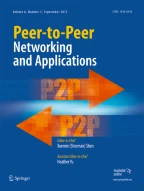Abstract
Today, wireless sensor networks (WSNs) have been widely used in monitoring various applications, such as environment, military and health-care, etc. The explosive growth of the data volume generated in these applications has led to one of the most challenging research issues of the big data era. To deal with such amounts of data, exploring data correlation and scheduling strategies have received great attention in WSNs. In this paper, we propose an efficient mechanism based on the Euclidean distance for searching the spatial-temporal correlation between sensor nodes in periodic applications. Based on this correlation, we propose two sleep/active strategies for scheduling sensors in the network. The first one searches the minimum number of active sensors based on the set covering problem while the second one takes advantages from the correlation degree and the residual energy of the sensors for scheduling them in the network. Our mechanism with the proposed strategies were successfully tested on real sensor data. Compared to other existing techniques, the simulation results show that our mechanism significantly extends the lifetime of the network while conserving the quality of the collected data and the coverage of the monitored area.
Similar content being viewed by others
Notes
The values 0 and 1 of the sensor mean that it can be on sleep or active mode respectively.
References
Liu C, Cao G (2011) Spatial-temporal coverage optimization in wireless sensor networks. IEEE Trans Mob Comput 10(4):465–478
Karuppasamy K, Gunaraj V (2013) Optimizing sensing quality with coverage and lifetime in wireless sensor networks. Int J Eng Res Technol 2(2):1–7
Tsai M-H, Huang Y-M (2014) A sub-clustering algorithm based on spatial data correlation for energy conservation in wireless sensor networks. J Sens 14(11):21858–21871
Idrees A, Deschinkel K, Salomon M, Couturier R (2014) Coverage and Lifetime Optimization in Heterogeneous Energy Wireless Sensor Networks. In: ICN 2014, 13-th Int. Conf. on Networks, Nice, France, pp 49–54
Villas LA, Boukerche A, Guidoni DL, de Oliveira HABF, de Araujo RB, Loureiro AAF (2013) An energy-aware spatio-temporal correlation mechanism to perform efficient data collection in wireless sensor networks. J Comput Commun 36(2013):1054–1066
Xu J, Wen MHF, Li VOK, Leung K-C (2013) Optimal PMU placement for wide-area monitoring using chemical reaction optimization. In: Proc. IEEE Innovative Smart Grid Technologies Conference (ISGT), Washington DC, U.S., pp 1–6
Jonhson D (1974) Approximation algorithms for combinatorial problem. J Comput Syst Sci 9:256–278
Madden S (2004) Intel Berkeley Research lab. http://db.csail.mit.edu/labdata/labdata.html
Dhimal S, Sharma K (2015) Energy conservation in wireless sensor networks by exploiting inter-node data similarity metrics. Int J Energy Inf Commun 6(2):23–32
Boopal N, Gunasekaran S, Mangai VA (2015) A survey of spatiotemporal data compression in wireless sensor networks. Int J Adv Res Comput Eng Technol 4(4):1182–1185
Pagar AR, Mehetre DC (2015) A survey on energy efficient sleep scheduling in wireless sensor network. Int J Adv Res Comput Sci Soft Eng 5(1):557–562
Makhoul A, Harb H, Laiymani D (2015) Residual energy-based adaptive data collection approach for periodic sensor networks. Ad Hoc Netw 35:149–160
Singh HK, Bharti J (2012) A novel solution for sleep scheduler in wireless sensor networks. Int J Adv Smart Sens Netw Syst 2(1):13–19
Bhosale AS, Khajure SR, Sharma MS (2015) Efficient data collection in wireless sensor networks using spatial correlation algorithm. Int J Recent Innovation Trends Comput Commun 3(2):418–423
Liu K, Zhuang Y, Wang Z, Ma J (2015) Spatiotemporal correlation based fault-tolerant event detection in wireless sensor networks. Int J Distrib Sens Netw 2015(643570):14
Piao X, Hu Y, Sun Y, Yin B, Gao J (2014) Correlated spatio-temporal data collection in wireless sensor networks based on low rank matrix approximation and optimized node sampling. Sensors 14:23137–23158
Gielow F, Jakllari G, Nogueira M, Santos A (2015) Data similarity aware dynamic node clustering in wireless sensor networks. Ad Hoc Netw 24:29–45
Chen S, Zhao C, Wu M, Sun Z, Jin J (2015) Clustered spatio-temporal compression design for wireless sensor networks. In: 24th International Conference on Computer Communication and Networks (ICCCN). IEEE, pp 1–6
Villas LA, Boukerche A, Guidoni DL, de Oliveira HABF, de Araujo RB, Loureiro AAF (2014) A spatial correlation aware algorithm to perform efficient data collection in wireless sensor networks. Ad Hoc Netw 12:69–85
Paczek B, Bernaś M (2014) Uncertainty-based information extraction in wireless sensor networks for control applications. Ad Hoc Netw 14:106–117
Baum D CIO information matters, big data, big opportunity. http://www.oracle.com/us/c-central/cio-solutions/informationmatters/big-data-big-opportunity/index.html
Business Bloomberg (2010) Sensor networks top social networks for big data. http://www.bloomberg.com/bw/technology/content/-sep2010/tc20100914_284956.htm
Wang T (2016) Research on data aggregation technology based on wireless sensor networks. Int J Future Generation Commun Netw 9(1):127–134
Kim H-Y (2016) An energy-efficient load balancing scheme to extend lifetime in wireless sensor networks, Cluster Computing, No. https://doi.org/10.1007/s10586-015-0526-9
Quan L, Xiao S, Xue X, Lu C (2016) Neighbor-aided spatial-temporal compressive data gathering in wireless sensor networks. IEEE Commun Lett PP(99):1
Harb H, Makhoul A, Couturier R (2015) An enhanced k-means and anova-based clustering approach for similarity aggregation in underwater wireless sensor networks. IEEE Sensors J 15(10):5483–5493
Oliveira LML, Rodrigues JJPC (2011) Wireless sensor networks: a survey on environmental monitoring. J Commun 6(2):143–151
Julie EG, Selvi ST (2016) Development of energy efficient clustering protocol in wireless sensor network using neuro-fuzzy approach. The Scientific World J 2016(5063261):8
Alghamdi TA (2016) Cluster based energy efficient routing protocol for wireless body area network. Trends Appl Sci Res 11(1):12–18
Acknowledgments
This project has been performed in cooperation with the Labex ACTION program (contract ANR-11-LABX-0001-01).
Author information
Authors and Affiliations
Corresponding author
Ethics declarations
Conflict of interests
The authors declare that they have no conflict of interest.
Additional information
This article is part of the Topical Collection: Special Issue on Network Coverage
Guest Editors: Shibo He, Dong-Hoon Shin, and Yuanchao Shu
Rights and permissions
About this article
Cite this article
Harb, H., Makhoul, A. Energy-efficient scheduling strategies for minimizing big data collection in cluster-based sensor networks. Peer-to-Peer Netw. Appl. 12, 620–634 (2019). https://doi.org/10.1007/s12083-018-0639-z
Received:
Accepted:
Published:
Issue Date:
DOI: https://doi.org/10.1007/s12083-018-0639-z
